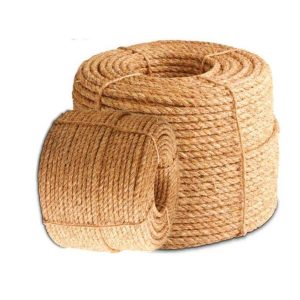
Coconut rope uses – The coconut shell is the outer part of the coconut that wraps around the coconut shell. The thickness of the coconut shell varies from 5 to 6 cm and consists of an outer layer (exocarp) and an inner layer (endocarp). The endocarp contains fine fibers that can be used as raw materials such as ropes, bags, pulp, carpets, brushes, carpets, thermal and acoustic insulation, filters, car upholstery, and fiberboard.
Coconut will produce coconut fiber and coconut powder when decomposed using a coconut crusher. However, the core of coconut products is coconut. In addition, various products can be made from coconut fibers, which have high economic value and are useful for daily needs. One of the by-products of coconut fiber processing is coconut rope.
Do you know what coco rope is? Coconut rope is very common and useful for us. Let’s look at the following explanation of coconut coir rope, which we can use well and more precisely. Coconut Rope is one of the coconut fiber crafts which is quite easy to make even if you are a beginner. The size and the diameter of the ropes sold in the market also vary depending on the thickness.
The skein of coir contained in the rope is called a ply. It is usually sold in the market in about 2-3 layers. In any case, it can be three-layered and is generally used in difficult work for lifting weights.
How to make rope from coconut
- First, peel the coconut shell with a coir machine.
- If using coconut shells, don’t make them too thin or too thick if possible.
- Then connect the coconut shell by twisting it. The length of the coconut rope can then be adjusted according to your needs.
- Finally, tie the two ends together.
- Completed. If you want to make it easier for yourself, you can use a coir rope spinning machine.
- Using Coconut Rope In Daily Needs
The coconut palm (Cocos nucifera) is one of the oldest plant families in the world, having been cultivated for at least 4,000 years. Known as “the tree that provides all of life’s necessities”. It is found in Sanskrit, which is the precursor to modern Hindi and Urdu. The coconut palm is the most useful tree in the world, for example, with benefits; food and beverages, fuels, fibers, and building materials. Coir rope has a variety of uses, including:
As liaison and shipbuilding | Coconut Rope Uses
Since ancient times, our ancestors have been making rope from coconut. The options for using this rope are very diverse. It starts with attaching the construction poles, so the importance of the rigging is for the delivery. The coconut fiber rope is transformed into something of great economic value with the progress of time, technology, and human resources.
Plant propagation medium
Crafts and decorations use coir rope for indoor and outdoor use. Coconut Rope is made from coconut fiber which is twisted into a larger size. Hanging flower pots with coconut twine can be a feast for the eyes and be aesthetically pleasing in your plant collection. In addition to hanging pots, coir rope can be used as a propagation medium for your favorite plants. They are usually called turrets or lianas. Usually, the type of plant that uses the turret is Monstera Adansonii. In addition, Monstera Adansoni is your ornamental plant. There are other plants that can be used, for example, as ornamental plants; mustard, and all types of philodendron.
As the main material for making Cocomesh/coco geotextile
Cocomesh or Coconut Coir Net is a natural solution to prevent erosion and abrasion, critical countermeasures associated with mining, increasing and creating vegetation on watersheds, etc. Cocomesh is made from coir waste by processing with a coir shredder. After the coir fiber is cut into small pieces, it is then sieved with a coir sieve to obtain individual fibers. This fiber is then twisted by machine or by hand to become a rope.